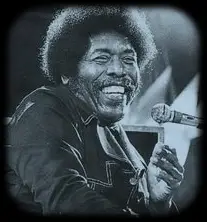JOHNNY ‘Big Moose’ WALKER

Shy, retiring characters don’t get called ‘Big Moose’, and loud barrelhouse pianist Johnny Walker got his tag from wearing his hair long and shaggy, but also for his wild personality. He was hugely popular with his fellow musicians for his energy and humour, and onstage he sometimes performed wearing a gorilla mask. When on tour in New Zealand he ‘went native’, living for a while as a member of a Maori community, perhaps as an echo of his own Native American heritage. Although he did not release a lot of solo material, his pounding left hand can be heard on hundreds of Chicago sessions in Moose’s long career as a sideman.
John Mayon Walker was born in the heart of the Delta, in Greenville MS in 1929, and he showed some musical ability as a kid on the church organ, also learning guitar, tuba and even vibraphone. He played barrelhouse piano around the local juke-joints, and acquired that ‘Big Moose’ tag working the circuit with Elmore James and appearing on the King Biscuit Time radio show with Rice ‘Sonny Boy II’ Miller. He then settled in Memphis, where he skipped around various Blues bands, playing with Ike Turner and Earl Hooker among others. His musical career was interrupted when he was drafted into the Korean War, and when he was discharged on the West Coast in 1955, Moose began playing in Lowell Fulson‘s band. He won a talent contest run by Johnny Otis and released a single on Johnny’s Ultra label under the name ‘Moose John’.
‘Ramblin’ Woman’ from Big Moose’s first album;
Moose gravitated to the Chicago scene in the late 50s, where his pounding style got him a lot of work as a sideman, especially alongside Earl Hooker and Elmore James, and he also played on many sessions with Otis Rush and Magic Sam in the 60s. Moose issued a few solo singles on small Chicago labels during this time, but his first album ‘Ramblin’ Woman’ came in 1969, again with Earl on guitar. While they were in California cutting that album, Moose worked on the memorable album ‘If You Miss ‘Im…I Got ‘Im’, with Earl and his cousin John Lee Hooker. Sadly, that was one of Earl’s last projects. When Moose returned to Chicago he played regularly with Jimmy Dawkins, Mighty Joe Young and Son Seals. Moose seemed ready to work in the studio or hit the road at the drop of a hat, and his recording credits in the 70s reads like a roster of the whole Chicago scene. Willie Dixon, Junior Wells and Lightnin’ Hopkins all used Moose, and he even toured with Muddy Waters playing bass. Moose joined Eddie Shaw’s Wolf Gang, which had been Howlin’ Wolf‘s band, and when they recorded for the Alligator series ‘Living Chicago Blues’, Bruce Iglauer had Moose cut some solo tracks with Louis Myers for the compilations.